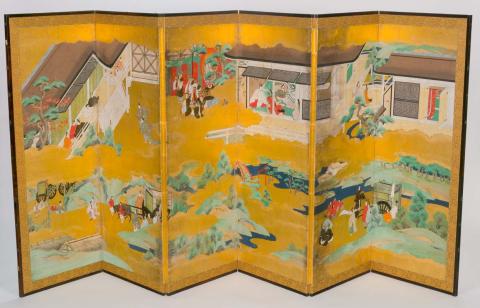Folding screens: Scenes from the Genji Monogatari
By Ellie Buttrose
Artlines | 1-2008 | March 2008
The Genji Monogatari (Tale of Genji) written by Murasaki Shikibu in the eleventh century is a literary classic. The Tale of Genji details the life of Genji, the son of the emperor, and his treasured consort. The story focuses on Genji’s relationships with his many romantic interests as well as his changing role within the emperor’s court. The Gallery’s newly acquired pair of folding screens depicts scenes from eight of the 54 chapters in the Tale of Genji, and portray the lavish entertainment that courtly life entailed in the golden period of Japan.
Chapter one, painted in the top right-hand corner of the right-hand screen, illustrates the presentation of an infant Genji to the emperor. The intricately detailed garments of the emperor and those in his close circle demonstrate their wealth and refined taste.
In another chapter, the emperor plans a visit to the Suzaku Palace. As his favoured consort is pregnant and unable to travel to the festivities at the palace, the emperor has arranged a full dress rehearsal to be staged for her before he departs. In the scene, and with autumn leaves and blooms in their hats, Genji and his friend Tō no Chūjō perform for the emperor and his favoured consort in the top left-hand corner of the left screen. The emperor watches unaware that his consort is not pregnant to him but to Genji.
At the top of the left screen, spring arrives and Murasaki (Genji’s favoured consort and the niece of his true love) is holding celebrations in her garden. The musicians are playing on boats decorated with phoenix and dragon’s heads. In the blooming garden Murasaki’s young attendants, dressed as birds and butterflies, deliver floral offerings before the seated guests.
In the bottom left-hand corner of the left screen, Genji is pictured with his son Yūgiri and other princes trying to escape the intense summer heat. This contrasts with the right-hand side depicting the tuning point in the tale when Yūgiri comes of age. A typhoon has hit the household and Yūgiri glimpses Murasaki for the first time and is taken by her beauty — protocol meant she lived unseen behind screens until this brief encounter. Murasaki’s room is ornamental — Chinese paintings of birds and flowers fill the walls of her room, glimpses of her prized garden can be seen beyond her doors and delicate robes adorn the women who join her. From this point in the tale Yūgiri’s relationships become more prominent.
In all the scenes portrayed on these screens, the traditional Japanese style of yamato-e is employed. This technique involves the use of simple lines to illustrate the eyes, nose and mouth of the characters. In contrast to the very simple facial features, the characters’ clothing is intricately patterned, and elaborately detailed interiors remain visible as the buildings are painted with only a partial roof. Billowing, golden clouds spread across both screens, separating one scene in the tale from the next and balancing the more heavily detailed moments in the painting. The artists display finesse by including Chinese landscape paintings in the buildings' interiors which contrast with the surrounds that have been painted in the yamato-e style. This contrast creates a rich visual landscape making the work accessible to those without an intimate knowledge of Genji’s story, while remaining a delight for those who are familiar with the tale.
